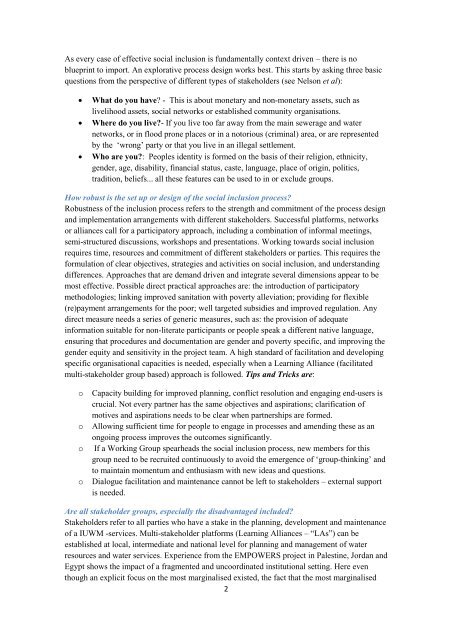Good practices for Social inclusion - Case studies and summary
Good practices for Social inclusion - Case studies and summary
Good practices for Social inclusion - Case studies and summary
Create successful ePaper yourself
Turn your PDF publications into a flip-book with our unique Google optimized e-Paper software.
As every case of effective social <strong>inclusion</strong> is fundamentally context driven – there is no<br />
blueprint to import. An explorative process design works best. This starts by asking three basic<br />
questions from the perspective of different types of stakeholders (see Nelson et al):<br />
<br />
<br />
<br />
What do you have? - This is about monetary <strong>and</strong> non-monetary assets, such as<br />
livelihood assets, social networks or established community organisations.<br />
Where do you live?- If you live too far away from the main sewerage <strong>and</strong> water<br />
networks, or in flood prone places or in a notorious (criminal) area, or are represented<br />
by the ‗wrong‘ party or that you live in an illegal settlement.<br />
Who are you?: Peoples identity is <strong>for</strong>med on the basis of their religion, ethnicity,<br />
gender, age, disability, financial status, caste, language, place of origin, politics,<br />
tradition, beliefs... all these features can be used to in or exclude groups.<br />
How robust is the set up or design of the social <strong>inclusion</strong> process?<br />
Robustness of the <strong>inclusion</strong> process refers to the strength <strong>and</strong> commitment of the process design<br />
<strong>and</strong> implementation arrangements with different stakeholders. Successful plat<strong>for</strong>ms, networks<br />
or alliances call <strong>for</strong> a participatory approach, including a combination of in<strong>for</strong>mal meetings,<br />
semi-structured discussions, workshops <strong>and</strong> presentations. Working towards social <strong>inclusion</strong><br />
requires time, resources <strong>and</strong> commitment of different stakeholders or parties. This requires the<br />
<strong>for</strong>mulation of clear objectives, strategies <strong>and</strong> activities on social <strong>inclusion</strong>, <strong>and</strong> underst<strong>and</strong>ing<br />
differences. Approaches that are dem<strong>and</strong> driven <strong>and</strong> integrate several dimensions appear to be<br />
most effective. Possible direct practical approaches are: the introduction of participatory<br />
methodologies; linking improved sanitation with poverty alleviation; providing <strong>for</strong> flexible<br />
(re)payment arrangements <strong>for</strong> the poor; well targeted subsidies <strong>and</strong> improved regulation. Any<br />
direct measure needs a series of generic measures, such as: the provision of adequate<br />
in<strong>for</strong>mation suitable <strong>for</strong> non-literate participants or people speak a different native language,<br />
ensuring that procedures <strong>and</strong> documentation are gender <strong>and</strong> poverty specific, <strong>and</strong> improving the<br />
gender equity <strong>and</strong> sensitivity in the project team. A high st<strong>and</strong>ard of facilitation <strong>and</strong> developing<br />
specific organisational capacities is needed, especially when a Learning Alliance (facilitated<br />
multi-stakeholder group based) approach is followed. Tips <strong>and</strong> Tricks are:<br />
o<br />
o<br />
o<br />
o<br />
Capacity building <strong>for</strong> improved planning, conflict resolution <strong>and</strong> engaging end-users is<br />
crucial. Not every partner has the same objectives <strong>and</strong> aspirations; clarification of<br />
motives <strong>and</strong> aspirations needs to be clear when partnerships are <strong>for</strong>med.<br />
Allowing sufficient time <strong>for</strong> people to engage in processes <strong>and</strong> amending these as an<br />
ongoing process improves the outcomes significantly.<br />
If a Working Group spearheads the social <strong>inclusion</strong> process, new members <strong>for</strong> this<br />
group need to be recruited continuously to avoid the emergence of ‗group-thinking‘ <strong>and</strong><br />
to maintain momentum <strong>and</strong> enthusiasm with new ideas <strong>and</strong> questions.<br />
Dialogue facilitation <strong>and</strong> maintenance cannot be left to stakeholders – external support<br />
is needed.<br />
Are all stakeholder groups, especially the disadvantaged included?<br />
Stakeholders refer to all parties who have a stake in the planning, development <strong>and</strong> maintenance<br />
of a IUWM -services. Multi-stakeholder plat<strong>for</strong>ms (Learning Alliances – ―LAs‖) can be<br />
established at local, intermediate <strong>and</strong> national level <strong>for</strong> planning <strong>and</strong> management of water<br />
resources <strong>and</strong> water services. Experience from the EMPOWERS project in Palestine, Jordan <strong>and</strong><br />
Egypt shows the impact of a fragmented <strong>and</strong> uncoordinated institutional setting. Here even<br />
though an explicit focus on the most marginalised existed, the fact that the most marginalised<br />
2

















